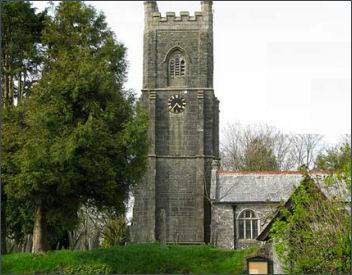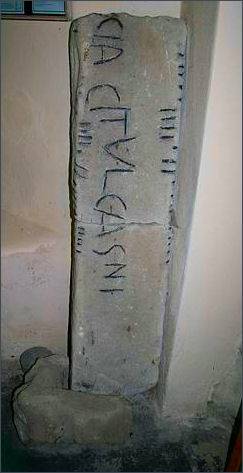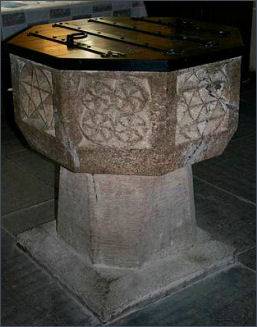Lewannick
OS Grid ref:- SX276807
 The small hilltop village of Lewannick is situated on the river Inny, around five miles (8 km) to the southwest of Launceston and a mile off the main A30 road. There are fine views over Bodmin Moor towards Fox Tor from the village. The name most probably means 'church site of Guenoc' a Breton saint.
The small hilltop village of Lewannick is situated on the river Inny, around five miles (8 km) to the southwest of Launceston and a mile off the main A30 road. There are fine views over Bodmin Moor towards Fox Tor from the village. The name most probably means 'church site of Guenoc' a Breton saint.
 Lewannick is of ancient origins, two inscribed pillar stones, each of which has text in both Latin and ogham (an old British alphabet) characters, may be found there. The pillar stones date to the between the fifth and sixth centuries. One is located at the south side of the village churchyard, a few metres west of the lych-gate. The text is very worn, and the top part cannot be made out at all. It was dedicated to a 'Ingenuus'.
Lewannick is of ancient origins, two inscribed pillar stones, each of which has text in both Latin and ogham (an old British alphabet) characters, may be found there. The pillar stones date to the between the fifth and sixth centuries. One is located at the south side of the village churchyard, a few metres west of the lych-gate. The text is very worn, and the top part cannot be made out at all. It was dedicated to a 'Ingenuus'.
The other Ogham Stome has been moved to inside to the nave of the church (pictured right), both texts mention an 'Ulcagnus'. Little is known about the origins of the Ogham stones at Lewannick, but it is thought that such stones commemorated Christian interment. The earliest inscriptions in ogham date to about the fourth century AD, but it is believes that its invention was within the 1st century BC. Various opinions exist on the exact origin of ogham. Some claim that it stemmed from a cryptic way of writing runes, some say that it was inspired from the Roman alphabet, and yet others hold that it was independently invented.
 The village church, which stands at the centre of Lewannick, is dedicated to St Martin of Tours, St. Martin was a Roman soldier whose shrine it to be found at Tours in Central France. He died in 397 and acquired a popular cult in mediaeval times.
The village church, which stands at the centre of Lewannick, is dedicated to St Martin of Tours, St. Martin was a Roman soldier whose shrine it to be found at Tours in Central France. He died in 397 and acquired a popular cult in mediaeval times.
A wooden Saxon Church probably occupied the site of the present building. Inside the building is a Norman font (pictured left) with partly recarved octagonal bowl which has unusually carved panels on its later shaft and base. There is also a Medieval Cresset stone with 7 cups, which was originally filled with tallow and used to light church by igniting the inserted wick.
The building was partly destroyed by a disastrous fire which occured on 11 January, 1890 and rebuilt by Otto. B. Peter of Launceston. While digging the foundations of the south columns of the church in 1890, workmen discovered the base stones of a twelfth century century building.
There are a number of old buildings in the village dating back to the fourteenth or fifteenth century and the nearby Manor of Trelaske is mentioned in the Doomesday Book of 1086.
Two miles south-west, in a wood in the valley of the river Lynher, stand the ruins of the medieval Upton Castle. It is thought to have been a twelfth century defended manor house and is the only one of it's type to exist in Cornwall. There are the remains of the outer walls but only at ground level.